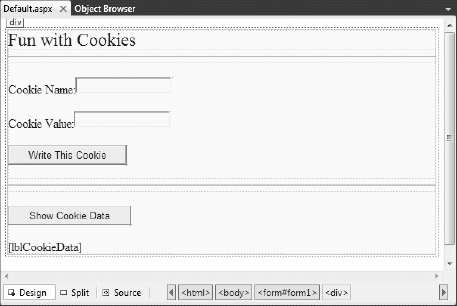The next state management technique we'll examine is the persisting of data within a cookie,
which is often realized as a text file (or set of files) on the user's
machine.When a user joint a given site, the browser checks to see whether the machine of the user has a cookie file for the URL in question and, if so, affixes these data at the request of HTTP.
The receiving server-side web page can then
read the cookie data to create a GUI based on the current user
preferences. I'm sure you've noticed that when you visit certain of
your favorite web sites, they somehow "just know" the sort of content
you wish to see. The reason (in part) may have to do with a cookie
stored on your computer that contains information relevant to a given
web site.
NOTE
The exact location of your cookie files will depend on which browser and operating system you happen to be using.
The contents of a given cookie file will obviously
vary among URLs, but keep in mind that they are ultimately text files.
Thus, cookies are a horrible choice for maintaining sensitive
information about the current user (such as a credit card number,
password, and the like). Even if you take the time to encrypt the data,
a crafty hacker could decrypt the value and use it for evil purposes.
In any case, cookies do play a role in the development of web
applications, so let's check out how ASP.NET handles this particular
state management technique.
1. Creating Cookies
First of all, understand that ASP.NET cookies can be configured to be either persistent or temporary. A persistent
cookie is typically regarded as the classic definition of cookie data,
in that the set of name/value pairs is physically saved to the user's
hard drive. A temporary cookie (also termed a session cookie)
contains the same data as a persistent cookie, but the name/value pairs
are never saved to the user's hard drive; rather, they exist only while the browser is open. Once the user shuts down the browser, all data contained in the session cookie is destroyed.
The System.Web.HttpCookie type is the class
that represents the server side of the cookie data (persistent or
temporary). When you wish to create a new cookie in your web page code,
you access the Response.Cookies property. Once the new HttpCookie is inserted into the internal collection, the name/value pairs flow back to the browser within the HTTP header.
To check out cookie behavior firsthand, create a new
Empty Web Site (named CookieStateApp) and create the UI of the first
Web Form (which you will need to insert) displayed in Figure 1.

Within the first button's Click event handler, build a new HttpCookie and insert it into the Cookie collection exposed from the HttpRequest.Cookies
property. Be very aware that the data will not persist itself to the
user's hard drive unless you explicitly set an expiration date using
the HttpCookie.Expires property. Thus, the following
implementation will create a temporary cookie that is destroyed when
the user shuts down the browser:
protected void btnCookie_Click(object sender, EventArgs e)
{
// Make a temp cookie.
HttpCookie theCookie =
new HttpCookie(txtCookieName.Text,
txtCookieValue.Text);
Response.Cookies.Add(theCookie);
}
However, the following generates a persistent cookie that will expire three months from today:
protected void btnCookie_Click(object sender, EventArgs e)
{
HttpCookie theCookie =
new HttpCookie(txtCookieName.Text,
txtCookieValue.Text);
theCookie.Expires = DateTime.Now.AddMonths(3);
Response.Cookies.Add(theCookie);
}
2. Reading Incoming Cookie Data
Recall that the browser is the entity in charge of
accessing persisted cookies when navigating to a previously visited
page. If a browser decides to send a cookie to the server, you can
access the incoming data in your *.aspx page via the HttpRequest.Cookies property. To illustrate, implement the Click event handler for the second button like so:
protected void btnShowCookie_Click(object sender, EventArgs e)
{
string cookieData = "";
foreach (string s in Request.Cookies)
{
cookieData +=
string.Format("<li><b>Name</b>: {0}, <b>Value</b>: {1}</li>",
s, Request.Cookies[s].Value);
}
lblCookieData.Text = cookieData;
}
If you now run the application and click
your new button, you will find that the cookie data has indeed been
sent by your browser and accessed successfully in your *.aspx code at the server.